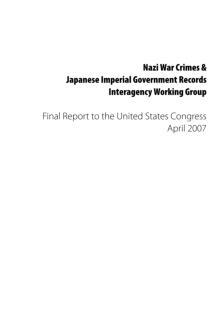Scientific papers 2007

Authors: E. Bardy, J. Mollendorf, D. Pendergast
This document describes active heating/cooling
experiments to thermally sustain a human subject
submerged in 10, 20, 30, and 40ºC water.


Authors: O. Hyldegaard, J. Madsen
In this report, the authors visually followed the in vivo
resolution of micro-air bubbles injected into adipose tissue
of anesthetized rats decompressed from 101.3 kPa to and
held at 71 kPa corresponding to 2.750 m above sea level,
while the rats breathed air, oxygen, heliox (50:50), or
heliox (80:20).
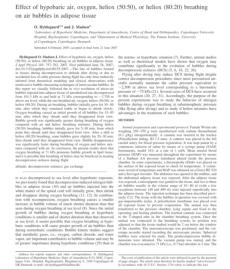

The presence of gas bubbles in the vascular system is
often considered a sign of decompression stress and
several studies in the existing literature have addressed the
relationship between the amount of bubbles detected by
ultrasound Doppler systems and the incidence of
decompression sickness. The use of ultrasound imaging
has some important advantages to Doppler systems, and
here the authors have looked at the relationship between
the amount of intravascular gas bubbles detected by
ultrasound echocardiography and the incidence of signs
and symptoms of decompression stress after 203 air dives.
They conclude that bubble detection by ultrasonic
scanning of the heart can be used as a tool to assess the
safety of decompression procedures for air dives.
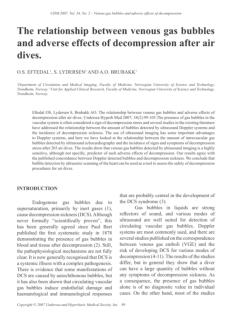

Authors:
Ksenya Katsenelson, Yehuda Arieli, Amir Abramovich,
Moshe Feinsod, Ran Arieli.
The authors hypothesized that the number of bubbles
evolving during decompression from a dive, and therefore
the incidence of decompression sickness (DCS), might be
reduced by pretreatment with hyperbaric oxygen (HBO).
The inert gas in the gas micronuclei would be replaced by
oxygen, which would subsequently be consumed by the
mitochondria. To investigate whether their hypothesis
holds for mammals, the authors pretreated rats with HBO
at 304, 405, or 507 kPa for 20 min, after which they were
exposed to air at 1,013 kPa for 33 min and decompressed
at 202 kPa/min.
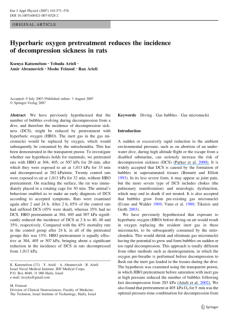

Authors: Jean-Eric Blatteau, Alain Boussuges, Emmanuel
Gempp, Jean-Michel Pontier, Olivier Castagna, Claude
Robinet, Francois-Michel Galland, Lionel Bourdon.
Sixteen trained military divers, aged 27–39 years, were
compressed in a hyperbaric chamber to 400 kPa for 30
min and decompressed at a rate of 100 kPa/min with a 9
min stop at 130 kPa (French Navy MN90 procedure).
Each diver performed two dives three days apart, one
without exercise and one with exercise before the dive. All
participants performed a 40 min constant-load
submaximal and calibrated exercise, which consisted of
outdoor running two h before the dive. Circulating
bubbles were detected with a precordial doppler at 30,
60, and 90 min after surfacing. Haemodynamic changes
were evaluated with doppler echocardiography.
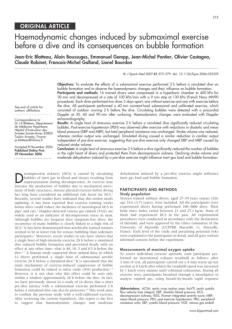

Authors: Andreas Møllerløkken, Christian Gutvik, Vegard J.
Berge, Arve Jørgensen, Are Løset, and Alf O. Brubakk.
There is a relationship between gas bubble formation in
the vascular system and serious decompression sickness.
Hence, control of the formation of vascular bubbles
should allow safer decompression procedures.
Twelve pigs were randomly divided into an experimental
group (EXP) and a control group (CTR) of 6 animals each.
The pigs were compressed to 500 kPa (5 ATA) in a dry
hyperbaric chamber and held for 90 min bottom time
breathing air. CTR animals were decompressed according
to a modified USN dive profile requiring four stops. EXP
followed the same profile except that 5-min
recompression of 50 kPa (0.5 ATA) was added at the end
of each of the last three decompression stop before
ascending to the next stop depth.
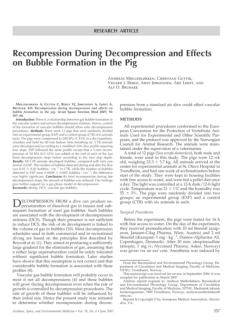

Authors: C. A. Duplessis, D. Fothergill, D. Shwaller, J.
Gertner.
Nitric oxide (NO) may decrease bubble formation in
diving. Statin medications are attractive potential options
to increase NO. Statins exhibit a proven safety profile and
possess a myriad of pleiotropic properties improving
vascular endothelial function. Additionally, statin-mediated
lipid reduction may reduce bubble generation via
alterations in plasma surface tension. The authors
investigated the efficacy of atorvastatin as a
pharmacological intervention to reduce the risk of bubble
formation after diving, a surrogate for decompression
sickness (DCS).
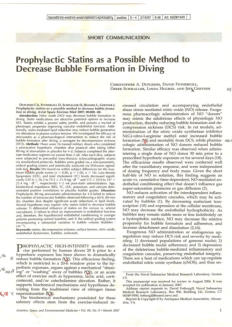





Authors: O. Hyldegaard, T. Jensen
To monitor the effects of heliox, oxygen, and air on helium
bubbles, helium bubbles from saturated rat adipose tissue
were studied at 101.3 kPa (1.013 bar) during breathing of
either heliox (80:20), 100% oxygen, or air after
decompression from exposure to heliox at 405 kPa (4.05
bar) for one hour.
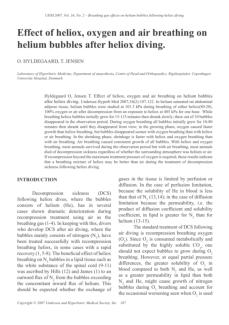

Author: Ran Arieli
It has been shown that the solubility of a gas in water
equilibrated with a mixture of gases is not, as postulated
by Henry’s law, a linear function of the gas pressure. This
phenomenon was explained by the effect of one
dissolved gas on the stabilization or destabilization of the
water structure, which affects the saturation solubility of
another gas. The theory suggests that reduced stability will
decrease the saturation solubility.
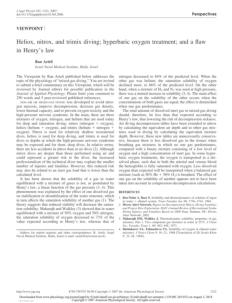

Author: R B Wienke
This small document from R B Wienke continues the
paper above from Ran Arieli. It relates experiments made
in the USN Los Alamo laboratory on Arieli’s query about
reduced solubility and risk for mixed gas diving.
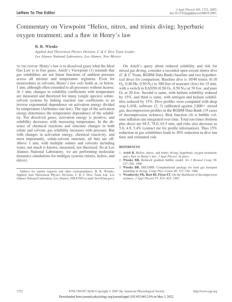

Authors: . Arieli, P. Svidovsky, and A. Abramovich
Trimix (a mixture of helium, nitrogen, and oxygen) has
been used in deep diving to reduce the risk of high-
pressure nervous syndrome during compression and the
time required for decompression at the end of the dive.
There is no specific recompression treatment for
decompression sickness (DCS) resulting from trimix diving.
This study aimed to validate a rat model of DCS on
decompression from a trimix dive and to compare
recompression treatment with oxygen and heliox (helium-
oxygen).
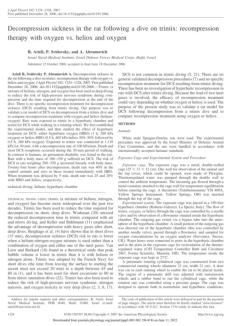
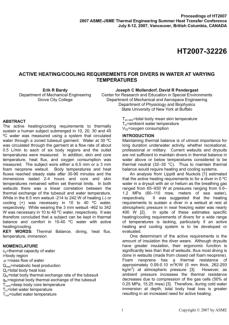

Authors: Pal Pacher, Joseph S. Beckman, Lucas Liaudet
Nitric oxide (NO) is an omnipresent intercellular
messenger in all vertebrates, modulating blood flow,
thrombosis, and neural activity. The biological production
of NO is also essential for nonspecific host defense, but
NO is unlikely to kill intracellular pathogens and tumors
directly. Although NO is often highly toxic and reactive, it
is not. In addition, NO can be produced for 80 years by
neurons in the human brain without overt toxicity.
Paradoxically, the production of the same molecule can
become highly damaging to the same neurons within a
few minutes during pathological challenges occurring
after cerebral ischemia.
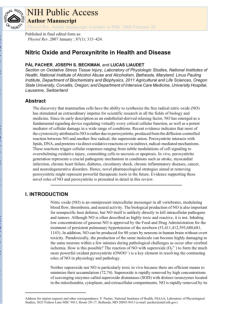

Authors:
John A. S. Ross, Jennifer I. Macdiarmid, Liesl M. Osman,
Stephen J. Watt, David J. Godden, and Andrew Lawson
A postal survey sent to 2958 male professional divers,
registered with the UK Health & Safety Executive (HSE)
before 1991, and 2708 men who had worked in the
offshore oil industry in 1990–92 (non-divers). The
questionnaire addressed lifestyle, occupation and health
status.
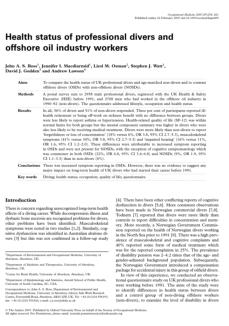

Authors: Wayne A. Gerth & David J. Doolette
The Thalmann Algorithm VVal-18 was a decompression
algorithm developed at the Navy Experimental Diving
Unit (NEDU) to produce 0.7 atmospheres absolute (ata)
constant PO2 -in-N2 decompression schedules. It was
used with a modified VVal-18 parameter set, designated
VVal-18M. This report documents the modifications to the
VVal-18 parameter set that resulted in VVal-18M and
described the accompanying updates to the Thalmann
Algorithm that were required to implement these
modifications correctly.
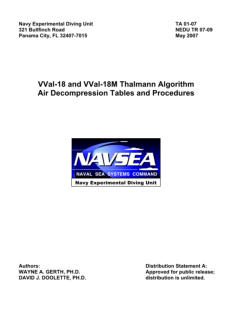

Author: John Hedley-Whyte
At sea level, oxygen is toxic to man when breathed for
more than twenty-four hours at a percentage greater
than forty percent. Pulmonary pathology is the first
manifestation in subjects with previously normal lungs. In
patients with pre-existing lung disease, the results are
often additive. There is, however, significant variation in
response from subject to subject and between patients.
Queen’s Belfast and Harvard University Medical Schools
have been the site of seminal investigations. Mentoring at
both universities is due to training at the University of
Copenhagen.
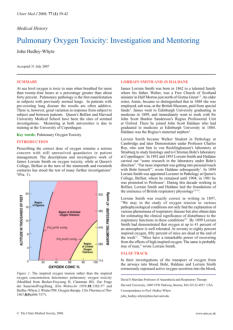

Author: Barbara Shykoff
This paper reports tests performed for four-hour dives,
including underwater exercise at PO2 = 1.3 atm with 20-
hour surface intervals between dives and three-hour dives
with 21-hour intervals. Doctor Shykoff concluded that
pulmonary changes do not accumulate with three-hour
dives with exercise at Pot = 1.3 atm when divers have 21
hours between dives and that this diving schedule can be
repeated indefinitely.
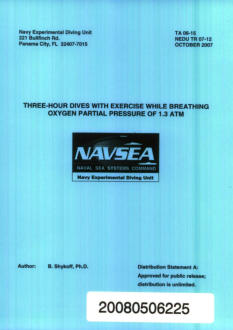

Authors:
Dror Tal, Peter Gilbey, Ronen Bar, and Avi Shupak
Seasickness is thought to result from conflicting inputs
from the vestibular, visual and somatosensory systems.
The otolithic organs, which are responsible for the
sensation of linear acceleration and tilt, are important in
the pathogenesis of seasickness. The vestibular evoked
myogenic potentials test is an objective evaluation of
saccular function.
The objective of this study is to examine whether saccular
function is related to the pathogenesis of seasickness.
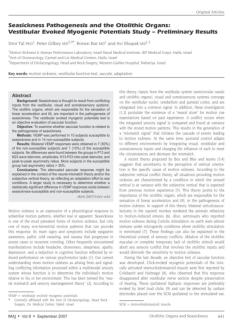

Authors: Alison C. Ma, and Neal W. Pollock
Diver selection is primarily based on medical fitness and
physical competency criteria. Physical competency is
generally evaluated through certification records and
initial tests of swimming skills and in-water diving abilities.
Continuation of active status requires periodic medical
evaluations, current emergency care certifications, and
documentation of diving activity exceeding minimum
requirements. While individual institutions and programs
may require additional evaluations, formal requirements
for periodic assessment of physical fitness are notably
absent from most standards
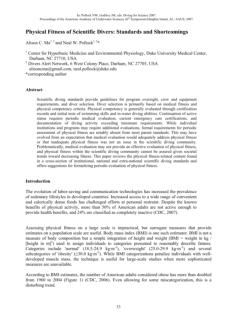

Click on the octopus
to return to the top
of the page



Author: Saul Goldman
Compartmental models have long been used in medicine
to study how different substances clear out of the body.
These models have been updated to help predict safe
decompression times for divers. The new models include a
main compartment that directly impacts safety and one or
two secondary compartments that exchange gases with
the main compartment. Studies show that models with
three compartments are more accurate than those with
two. This finding could change diving practices if further
tests confirm the models' predictions.
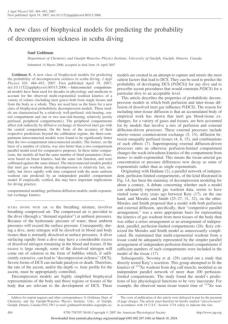

Author: Neal W Pollock
Techniques for ultrasound assessment of decompression
stress continue to evolve with technological
advancements.
While aural Doppler remains the standard, imaging
techniques are becoming increasingly popular. Current
initiatives to increase the resolution of three-dimensional
and dual-frequency imaging promise to expand our
monitoring capabilities further. Understanding the
limitations and strengths of ultrasound assessment is
essential for interpreting existing decompression studies
and designing new studies.
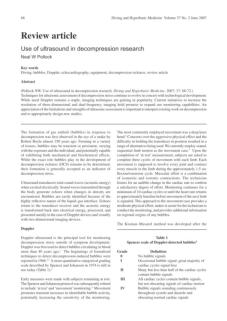



Authors: Guy C. Brown, Vilmante Borutaite
Nitric oxide (NO) inhibits the mitochondrial respiratory
chain, reducing Adenosine triphosphate (ATP)
production, increased oxidant production, and higher
susceptibility to cell death.
In the heart, NO is produced by endothelial NO synthase
(eNOS) in the endothelium and caveolae of
cardiomyocytes, by neuronal NO synthase (nNOS) in the
sarcoplasmic reticulum and possibly mitochondria, and
under pathological conditions by inducible NO synthase
(iNOS) in the sarcoplasm.
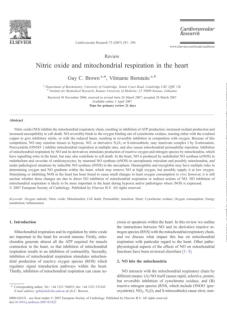

Authors: Ivan T. Demchenko, Karen E. Welty-Wolf, Barry
W. Allen, and Claude A. Piantadosi
The study examined the pulmonary effects of oxygen
toxicity in rats exposed to 98% oxygen at pressures of 1,
1.5, 2, 2.5, and 3 ATA. The goal was to determine if
different lung injury patterns would indicate a role for CNS
excitation by hyperbaric oxygen. The study concludes that
extrapulmonary, neurogenic events predominate in the
pathogenesis of acute pulmonary oxygen toxicity in
hyperbaric oxygenation, as Neuronal Nitric Oxide
Synthase (nNOS) activity drives lung injury by modulating
the output of central autonomic pathways.
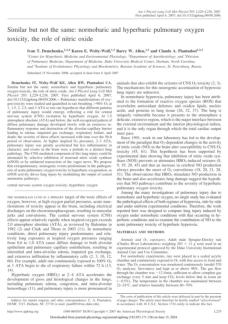

Authors: Zoran Valic, Ivan Palada, and Zeljko Dujic
This paper examines the effects of a short-acting nitric
oxide (NO) donor on decompression sickness in humans.
It provides evidence that pharmacological interventions
targeting nitric oxide signaling may be a promising
approach for preventing decompression sickness in
humans exposed to rapid changes in ambient pressure,
such as during scuba diving or aerospace activities.
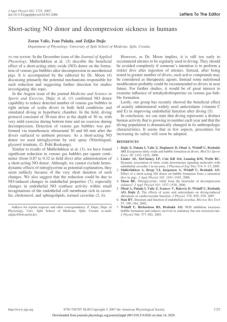

Authors: Andrew J. Young & John W. Castellani
Participants in prolonged, physically demanding activities
in cold weather are at risk of "hiker's hypothermia." This
condition arises when physiological responses, clothing,
and behavioral strategies do not adequately balance the
body's heat loss in a cold environment. Scientific literature
indicates that prolonged or repeated cold exposure,
sustained physical exertion-induced fatigue, or a
combination of both can impair the body's shivering and
vasoconstrictor responses to cold
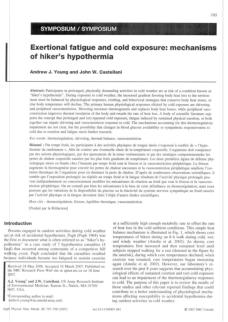

Authors: Olav Sande Eftedal
This document is a thesis submitted by Olav Sande Eftedal
in September 2007 in support of the degree of Doctor of
Philosophy at the Norwegian University of Science and
Technology, Faculty of Medicine / Department of
Circulation and Medical Imaging in Trondheim,
Torgarden, Norway
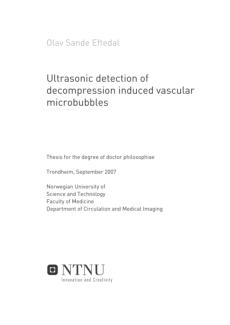

Authors:
Paul S. Pagel, John G. Krolikowski, Yon Hee Shim,
Suneetha Venkatapuram, Judy R. Kersten, Dorothee
Weihrauch, David C. Warltier, Phillip F. Pratt
The study investigates whether noble gases without
anesthetic properties, such as helium (He), neon (Ne), and
argon (Ar), can provide cardioprotection similar to xenon.
The researchers hypothesized that these gases confer
cardioprotection by activating prosurvival signaling kinases
and inhibiting the opening of the mitochondrial
permeability transition pore (mPTP). The results showed
that He, Ne, and Ar significantly reduced myocardial
infarct size in rabbits, comparable to ischemic
preconditioning.
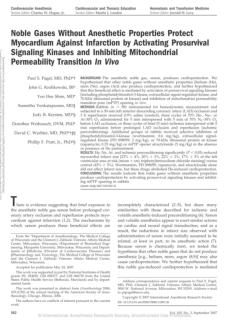

Authors:
Agot Irgens, Marit Grønning, Kari Troland, Endre Sundal,
Harald Nyland, and Einar Thorsen.
The study examined the effects of decompression sickness
(DCS) and diving exposure on the health-related quality of
life (HRQL) in former Norwegian North Sea divers. A
questionnaire collected HRQL data from 375 divers
registered before 1990, with detailed data from 230
divers. The findings indicated that HRQL was generally
reduced among these divers experiencing DCS during
their careers, significantly lowering scores.
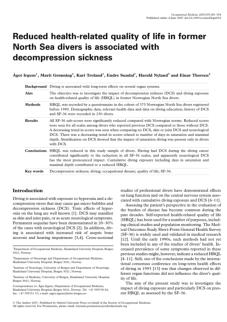

Author: A.E. Talpalar
This document examines the effects of high-pressure
neurological syndrome that begin at around 1.3 MPa
(120 meters) and worsen with depth. Initial symptoms
include tremors, nausea, and cognitive disturbances,
potentially leading to severe tremors, vomiting,
hyperreflexia, sleepiness, psychomotor and mental
impairments, fasciculations, myoclonia, psychosis, and
seizures. Electrophysiological studies show changes in
brain activity and nerve conduction during HPNS. Studies
indicate that HPNS symptoms are progressive and
pressure-dependent.
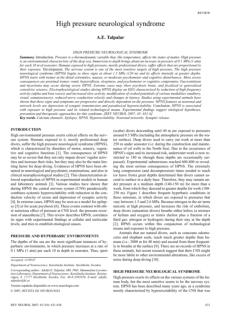

Authors:
John R. Claybaugh, Yu-Chong Lin, Heinrich G. Schafstall,
and Peter B. Bennett
This study investigates the impact of hyperbaria on
diuresis, particularly focusing on arginine vasopressin
(AVP) and atrial natriuretic peptide (ANP). Results showed
a significant increase in tilt-stimulated plasma renin activity
(PRA), while the AVP response was generally absent,
except during tilt-induced syncope. Contrary to some
previous reports, both supine and tilt-suppressed levels of
ANP were reduced by about 50% under hyperbaric
conditions compared to control values.
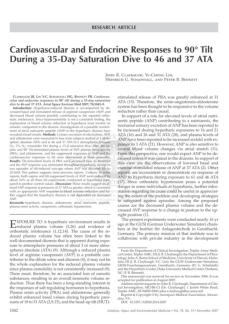

Authors: David Soo-Quee Koh, Gerald Choon-Huat Koh
This document highlights the advantages of using saliva
as a diagnostic fluid compared to other methods like
phlebotomy. It emphasizes the non-invasive nature, ease
of collection, safety, and real-time biomarker reflection of
saliva, making it a preferable option for both patients and
researchers.
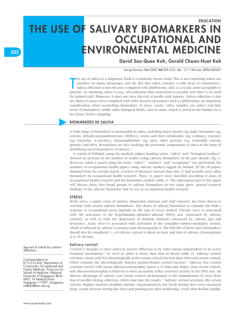

Authors: C. E. Fife, D. R. Smart, P. J. Sheffield, H. W. Hopf,
G. Hawkins, D. Clarke
This study provides information and guidelines regarding
transcutaneous oximetry (PtcO2) as a diagnostic tool for
assessing oxygen tension in wounds, ulcers, and skin flaps.
It aims to educate healthcare professionals about the
significance of PtcO2 measurements, the conditions under
which they are taken, and their implications for patient
outcomes, particularly regarding tissue hypoxia, vascular
disease, and healing predictions post-amputation or
revascularization. It also summarizes consensus statements
from an expert panel to guide clinical practice.
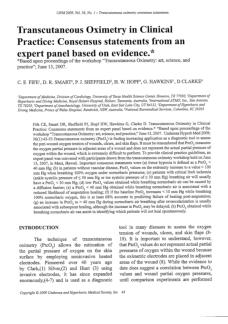

Authors:
Lorne R Gale, Yi Chen, Brian A Hills, and Ross Crawford
The authors of this study present research findings on the
identity and role of surface-active phospholipids (SAPLs) in
synovial fluid as a lubricant in diarthrodial joints. They
discuss the methods used to analyze these components,
the results obtained from the analysis of prostheses, and
the implications of these findings for the development of
artificial joints and treatments for diseases related to joint
lubrication.
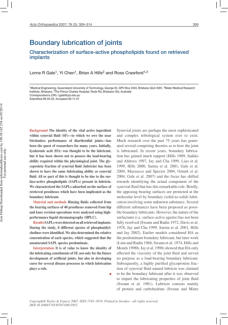

Authors: P.B. Bennett, A. Marroni, F.J. Cronje, R. Cali-
Corleo, P. Germonpre, M. Pieri, C. Bonuccelli,
M.G. Leonardi, and C. Balestra
This paper discusses research findings on the optimal stop
times during decompression dives to reduce precordial
Doppler detectable bubbles (PDDB). It evaluates the
effectiveness of varying deep and shallow stop times and
provides recommendations based on the results. The
authors aim to clarify the optimal stop times for reducing
PDDB, suggesting a deep stop of at least 2 ½ minutes at
15 msw (50 fsw) and a shallow stop of 3-5 minutes at 6
msw (20 fsw) for dives to 25 meters lasting 20 to 25
minutes.
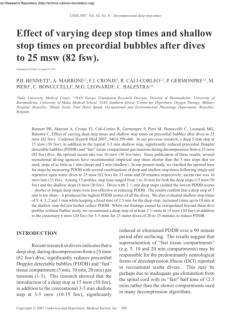



34 - Pulmonary effects of submerged oxygen breathing in resting
divers: repeated exposures to 140 kPa

Author: Barbara Shykoff
To study the effects of oxygen exposure at 130–140 kPa,
we evaluated pulmonary toxicity after various dive
durations. Four-hour dives were manageable for at least
ten days with 20-hour intervals, while six-hour dives
showed more symptoms and fatigue.
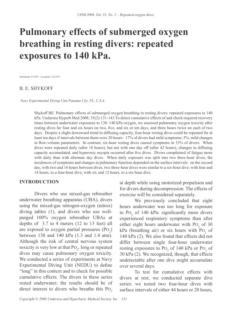



07 - Nazi War Crimes and Japanese Imperial Government Records
Interagency Working Group - Final Report to the United States
Congress

The Nazi War Crimes and Japanese Imperial
Government Records Interagency Working Group
(IWG) was established by the U.S. government to locate,
identify, inventory, and recommend for declassification
classified records related to Nazi and Japanese Imperial
Government war crimes. Created under the Nazi War
Crimes Disclosure Act of 1998 and the Japanese Imperial
Government Disclosure Act of 2000, the IWG aimed to
make these records accessible to the public and
researchers
